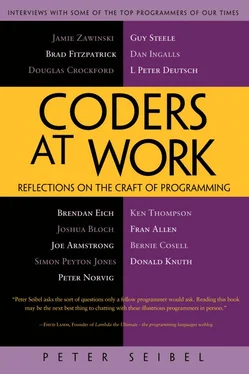Peter Seibel - Coders at Work - Reflections on the craft of programming
Здесь есть возможность читать онлайн «Peter Seibel - Coders at Work - Reflections on the craft of programming» весь текст электронной книги совершенно бесплатно (целиком полную версию без сокращений). В некоторых случаях можно слушать аудио, скачать через торрент в формате fb2 и присутствует краткое содержание. Жанр: Программирование, на английском языке. Описание произведения, (предисловие) а так же отзывы посетителей доступны на портале библиотеки ЛибКат.
- Название:Coders at Work: Reflections on the craft of programming
- Автор:
- Жанр:
- Год:неизвестен
- ISBN:нет данных
- Рейтинг книги:3 / 5. Голосов: 1
-
Избранное:Добавить в избранное
- Отзывы:
-
Ваша оценка:
- 60
- 1
- 2
- 3
- 4
- 5
Coders at Work: Reflections on the craft of programming: краткое содержание, описание и аннотация
Предлагаем к чтению аннотацию, описание, краткое содержание или предисловие (зависит от того, что написал сам автор книги «Coders at Work: Reflections on the craft of programming»). Если вы не нашли необходимую информацию о книге — напишите в комментариях, мы постараемся отыскать её.
Coders at Work
Founders at Work
Coders at Work: Reflections on the craft of programming — читать онлайн бесплатно полную книгу (весь текст) целиком
Ниже представлен текст книги, разбитый по страницам. Система сохранения места последней прочитанной страницы, позволяет с удобством читать онлайн бесплатно книгу «Coders at Work: Reflections on the craft of programming», без необходимости каждый раз заново искать на чём Вы остановились. Поставьте закладку, и сможете в любой момент перейти на страницу, на которой закончили чтение.
Интервал:
Закладка:
Systems are filled with so much goop—in order to build an ASP.NET web service-y thing you need to know about this API and this tool and you need to write in three different languages and you need to know about Silverlight and LINQ and you can go on doing acronyms forever. And each of them has a fat book that describes it.
This is a tension I don’t know how to resolve. These are useful systems—they’re not designed by accident. Each of them is there for a reason and each of them has a smart person who’s thinking hard about how this thing should be architected. But nevertheless, each, individually, has a broad interface. It may or may not be deep but it’s certainly broad. There’s a lot of stuff you need to just have in your head. It’s like learning a language—a human language—there’s a large vocabulary.
For me, that’s no fun. I never learned my multiplication tables. I always worked them out from first principles every time and I just developed enough tricks that I could do it quickly enough. When you do seven nines I still have to go, oh, seven nines, oh, seven tens and subtract, so it’s sixtythree. Whereas other people just learnt them. And that’s a relatively small thing. So I hate things were you just have to learn these big things. So instinctively I back away from these big goopy things. But at the same time I acknowledge that they’re useful and important in practice. The question in my mind is, if you were able to take a bit longer to design some of these things, could they be designed with smaller, less complicated, and less ad hoc interfaces?
Seibel:Sometimes it seems that it’s exactly because each of these blobs has some smart person or people working on it and each smart person wants their own little playground to play in, that things get so complicated.
Peyton Jones:I’m sure there’s an element of that. But to put a more positive construction on it, if you like, it’s a big, complicated world and there’s a lot to get done. If you had a grand Olympian vision—if you had a very large brain and enormous throughput—you might be able to do something with less overlap and more overall coherence.
But in practice we have to factor these problems into little chunks. And then the little chunks each have somebody who looks after it and who’s conditioned by the things they’ve done before and their heritage. So maybe they design something within that space that may not be as good as it could possibly be—they’re pressed for time. And certainly by the time you look at the combination of everything it’s maybe quite a lot less good than it could possibly be. And then before you know it you’re locked into a legacy problem—that’s another reason that things are not as good as they could possibly be.
So there’s a tremendous legacy ball and chain that’s being dragged around. It’s one of the nice things about Haskell. When I gave a retrospective on Haskell at, I think it was POPL 2004 or something, I put up a slide that said one of the things we’ve learned to do in Haskell is to “avoid success at all costs.” This is clearly a sort of meme because people remember that phrase and they quote it back to me.
It has a grain of truth in it because it means by not being too successful, too early, we’ve been able to morph Haskell quite a lot during its life. And part of the reason that I’m feeling a bit manic at the moment is because Haskell has become more successful and so I get more bug reports, more feature requests. And more people saying, “Don’t break my program please.” That didn’t use to happen.
Seibel:You’ve mentioned writing beautiful code a couple of times. What are the characteristics of beautiful code?
Peyton Jones:Tony Hoare has this wonderful turn of phrase in which he says your code should obviously have no bugs rather than having no obvious bugs. So for me I suppose beautiful code is code that is obviously right. It’s kind of limpidly transparent.
Seibel:What about those little jewels of code that you almost have to puzzle out how they work but once you do, it’s amazing. Are those also beautiful?
Peyton Jones:Sometimes to say that it’s obviously right doesn’t mean that you can see that it’s right without any mental scaffolding. It may be that you need to be told an insight to figure out why it’s right. If you look at the code for an AVL tree, if you didn’t know what it was trying to achieve, you really wouldn’t have a clue why those rotations were taking place. But once you know the invariant that it’s maintaining, you can see, ah, if we maintain that invariant then we’ll get log lookup time. And then you look at each line of code and you say, “Ah, yes, it maintains the invariant.” So the invariant is the thing that gave you the insight to say, “Oh, it’s obviously right.”
I agree completely that just looking at the bare code may not be enough. And it’s not a characteristic, I think, of beautiful code, that you should be able to just look at the bare code and see why it’s right. You may need to be told why. But after you have that, now with that viewpoint, that invariant, that understanding of what’s going on, you can see, oh yeah, that’s right.
Seibel:Does that put an upper bound on how big a piece of software can be and still be beautiful?
Peyton Jones:I don’t know if it’s a bound on its size. The insights that you need in order to reassure yourself that it’s right, or at least right-ish, are along the lines of being more confident that it’s correct. Any really, really big piece of software is bound to have shortcomings or indeed outright things that you just know are wrong with it. But it’s not economic to fix them at the moment. It’s certainly true of GHC and it’s definitely true of Microsoft’s software.
But what makes big software manageable is having some global invariants or big-picture statements about what it’s supposed to do and what things are supposed to be true. So, to take GHC as another example, having this invariant that each of these intermediate programs should be well typed. That can be checked, actually, at runtime if you like. That’s quite a powerful invariant about what’s going on. So I’m not sure it’s really necessarily to do with size.
Certainly interconnectedness makes big programs eventually crumble under their own weight. Sometimes one of the luxuries that you get from working in research is that you can sometimes take a chunk of code and simply rewrite it in the light of your improved insights into what you were trying to achieve and how you might try to achieve it. We talked about this business of refactoring GHC’s back end. If I was working in a more commercial setting, I might not be able to afford to do that. But I’m hoping that it will make GHC more maintainable and understandable in the long term.
Is there an upper bound on the size? I don’t know. I rather suspect that as long as we can go on building good abstractions we can keep building bridges across the Atlantic. We have software that works—not perfectly, but surprisingly well considering how big it is.
Seibel:So the question is, can you build an edifice that’s that large, and works, and is also beautiful.
Peyton Jones:It’s hard for it to maintain its beauty. Bits are often beautiful or at least acceptably non-ugly when they’re first built. In the face of protracted life—maintenance—it’s quite difficult to maintain that. That’s the worst thing about long-lived programs… that they gradually become ugly. So there’s no moment at which they become disfigured but nevertheless after a while they just become crappy.
Читать дальшеИнтервал:
Закладка:
Похожие книги на «Coders at Work: Reflections on the craft of programming»
Представляем Вашему вниманию похожие книги на «Coders at Work: Reflections on the craft of programming» списком для выбора. Мы отобрали схожую по названию и смыслу литературу в надежде предоставить читателям больше вариантов отыскать новые, интересные, ещё непрочитанные произведения.
Обсуждение, отзывы о книге «Coders at Work: Reflections on the craft of programming» и просто собственные мнения читателей. Оставьте ваши комментарии, напишите, что Вы думаете о произведении, его смысле или главных героях. Укажите что конкретно понравилось, а что нет, и почему Вы так считаете.












